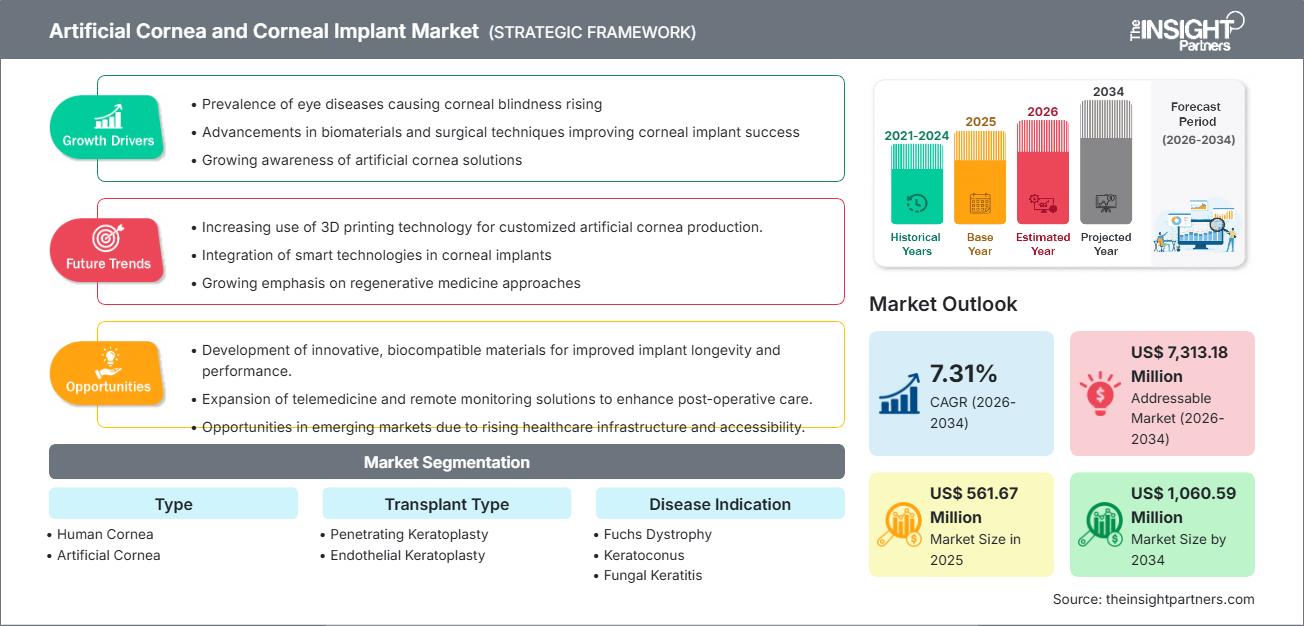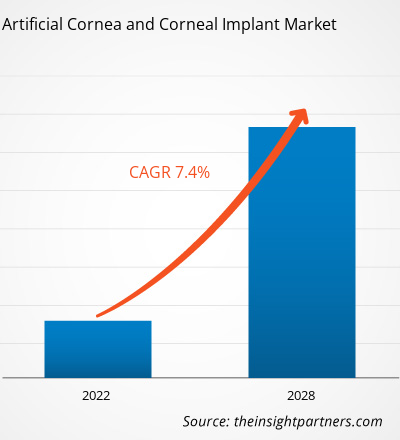인공 각막 및 각막 임플란트 시장 규모는 강력한 성장세를 보이며 2025년 5억 6,167만 달러에서 2034년 10억 6,059만 달러에 이를 것으로 예상됩니다. 이 시장은 2026년부터 2034년까지 예측 기간 동안 연평균 성장률(CAGR) 7.31%를 기록할 것으로 전망됩니다.
인공 각막 및 각막 임플란트 시장 분석
전 세계 인공 각막 및 각막 이식 시장은 꾸준하고 가속화되는 성장을 보일 것으로 예상되며, 이는 주로 시력 손상 및 실명의 주요 원인인 각막 질환 및 장애의 전 세계적인 증가에 기인합니다. 고품질 인간 기증 각막의 심각하고 지속적인 전 세계적 부족 현상은 시장 성장을 뒷받침하는 근본적인 요인입니다. 이러한 부족 현상은 외과의와 의료 시스템이 합성 대체재 및 혁신적인 이식 기술을 도입하도록 적극적으로 유도하고 있습니다. 향상된 생체 적합성을 지닌 우수한 생체 재료의 사용과 최소 침습 수술 기법의 발전 등 첨단 안과 솔루션 분야의 기술 혁신은 환자 치료 결과를 획기적으로 개선하고 거부 반응률을 낮추며 이러한 각막 복원 솔루션의 전 세계적인 도입을 가속화하고 있습니다.
인공 각막 및 각막 임플란트 시장 개요
인공 각막과 각막 임플란트는 기존의 방법으로는 교정할 수 없는 심각한 각막 손상이나 질환을 겪는 환자의 시력을 치료적으로 회복시키기 위해 고안된 특수 의료 기기 및 생체 조직입니다. 이러한 솔루션에는 전통적인 각막 이식 수술에 사용되는 인간 기증자 각막과 자연 각막의 화학적, 광학적 특성을 모방하도록 설계된 합성 대체물(각막 보철물)이 모두 포함됩니다. 시장은 장기적인 내구성과 통합성을 향상시킨 차세대 임플란트를 개발하기 위한 집중적인 연구 개발 투자로 특징지어집니다. 또한, 새로운 디자인에 대한 규제 승인이 증가하고 있으며, 안과 기술 개발업체, 안구 은행 및 주요 의료 서비스 제공업체 간의 전략적 협력을 통해 이러한 삶을 변화시키는 각막 이식 수술의 접근성과 경제성을 향상시키고 있습니다.
이 보고서를 귀하의 요구사항에 맞게 맞춤 설정하십시오.
모든 보고서에 대한 맞춤형 서비스(본 보고서의 일부 또는 국가별 분석, Excel 데이터 팩 포함)를 무료로 제공해 드립니다. 또한 스타트업 및 대학을 위한 다양한 할인 혜택도 누리실 수 있습니다.
인공 각막 및 각막 임플란트 시장: 전략적 고찰

-
이 보고서에서 주요 시장 동향을 확인하세요.이 무료 샘플에는 시장 동향부터 추정치 및 예측에 이르기까지 다양한 데이터 분석이 포함됩니다.
인공 각막 및 각막 임플란트 시장 동인 및 기회
시장 동인:
- 전 세계적으로 각막 질환으로 인한 실명 및 관련 질환의 유병률 증가: 푸크스 각막이영양증, 원추각막, 감염성 각막염과 같은 각막 질환의 전 세계적인 발생률 증가는 수술적 치료를 필요로 하는 환자 수를 크게 늘려 시장의 주요 인구 통계학적 동인이 되고 있습니다.
- 기증 각막 부족으로 인공 대체재 수요 증가: 전 세계적으로 생존 가능한 인간 기증 각막 공급과 이식 수술 수요 간의 지속적인 불균형으로 인해 시장은 신뢰할 수 있고 접근성이 뛰어나며 생명을 구할 수 있는 대체재로서 제조된 합성 각막 보철물의 개발 및 도입을 촉진하고 있습니다.
- 생체재료 및 수술 기법의 기술 발전: 고도의 생체적합성 고분자 및 하이드로겔 개발로 이어지는 재료 과학의 지속적인 혁신과 새로운 수술 방법(예: 심부 전층 각막이식술 - DALK 및 데스메트막 내피 각막이식술 - DMEK)의 성공적인 도입이 결합되어 이식 성공률이 높아지고 치료 대상 환자 범위가 확대되고 있습니다.
시장 기회:
- 생체 적합성이 향상된 차세대 인공 각막 개발: 인공 각막 관련 기술을 개선하여 숙주 조직과의 통합을 극대화하고 감염이나 거부 반응의 장기적인 위험을 최소화하는 것은 중요한 상업적 기회입니다. 특히 표면 개질 및 새로운 소재 선택은 상당한 가능성을 제시합니다.
- 안과 진료 인프라 개선을 통한 신흥 시장 확대: 아시아 태평양 및 라틴 아메리카 국가들은 치료받지 못한 각막 실명 환자가 대규모로 쌓여 있는 상황으로, 상당한 미개척 시장을 보유하고 있습니다. 민간 안과 센터의 성장과 보험 적용 범위 확대는 기증 조직 및 합성 임플란트의 도입을 가속화할 것입니다.
- 혁신과 글로벌 유통을 위한 전략적 파트너십: 전문 안과 기업과 대형 의료기기 유통업체 간의 협력은 글로벌 규모 확장을 달성하는 데 핵심적인 요소이며, 특히 기증 조직에 필요한 복잡한 공급망 물류와 새로운 이식 기술을 도입하는 외과의에게 필요한 임상 교육을 원활하게 진행하는 데 중요합니다.
인공 각막 및 각막 임플란트 시장 보고서 세분화 분석
인공 각막 및 각막 임플란트 시장 점유율은 다양한 제품 유형, 수술 절차, 기저 질환 상태 및 최종 사용자 환경을 반영하여 여러 부문에 걸쳐 엄격하게 분석됩니다. 아래는 대부분의 산업 보고서에서 사용되는 표준 시장 세분화 방식입니다.
유형별:
- 인간 각막
- 인공 각막 (각막보철물)
이식 유형별:
- 투과성 각막 이식술(PKP)
- 내피 각막 이식술(EK)
질병별 적응증:
- 푸크스 내피세포 이영양증
- 원추각막
- 각막 궤양 및 흉터
최종 사용자 기준:
- 병원
- 전문 클리닉 및 외래 수술 센터(ASC)
지리학별:
- 북아메리카
- 유럽
- 아시아 태평양
- 남미 및 중앙아메리카
-
중동 및 아프리카
인공 각막 및 각막 임플란트 시장 지역별 분석
인사이트 파트너스의 분석가들은 예측 기간 동안 인공 각막 및 각막 임플란트 시장에 영향을 미치는 지역별 동향과 요인을 자세히 설명했습니다. 이 섹션에서는 북미, 유럽, 아시아 태평양, 중동 및 아프리카, 남미 및 중앙아메리카를 아우르는 인공 각막 및 각막 임플란트 시장 세분화와 지역별 현황도 다룹니다.
인공 각막 및 각막 임플란트 시장 보고서 범위
| 보고서 속성 | 세부 |
|---|---|
| 2025년 시장 규모 | 미화 5억 6,167만 달러 |
| 2034년 시장 규모 | 미화 10억 6,059만 달러 |
| 글로벌 연평균 성장률(2026년~2034년) | 7.31% |
| 역사적 데이터 | 2021-2024 |
| 예측 기간 | 2026-2034 |
| 포함되는 부문 |
유형별로
|
| 대상 지역 및 국가 |
북아메리카
|
| 시장 선도 기업 및 주요 기업 프로필 |
|
인공 각막 및 각막 임플란트 시장 참여자 밀도: 비즈니스 역학에 미치는 영향 이해
인공 각막 및 각막 임플란트 시장은 소비자 선호도 변화, 기술 발전, 제품 효능에 대한 인식 제고 등 여러 요인으로 최종 사용자 수요가 증가하면서 빠르게 성장하고 있습니다. 수요가 증가함에 따라 기업들은 제품군을 확장하고, 소비자 요구를 충족하기 위한 혁신을 추진하며, 새로운 트렌드를 활용하여 시장 성장을 더욱 촉진하고 있습니다.

- 인공 각막 및 각막 임플란트 시장의 주요 업체 개요를 확인하세요.
인공 각막 및 각막 임플란트 시장 점유율 분석 (지역별)
북미는 세계 시장에서 지배적인 위치를 유지하고 있는 반면, 아시아 태평양 지역은 접근성 및 인지도 향상으로 인해 가장 빠른 성장을 보일 것으로 예상됩니다.
시장의 지역별 성과는 의료비 지출, 신규 기기에 대한 규제 장벽, 그리고 수술 건수가 많은 안과 전문의들의 확고한 입지에 크게 영향을 받습니다. 아래는 지역별 시장 점유율 및 동향 요약입니다.
북아메리카
- 시장 점유율: 세계 최대 시장 점유율을 차지하고 있으며, 이는 탁월한 안과 진료 시설, 높은 1인당 의료비 지출, 그리고 세계적인 의료기기 제조업체와 주요 안구은행의 강력한 입지에 기인합니다.
- 주요 동인: 첨단 각막 이식 시술에 대한 유리한 보험금 지급 정책.
- 동향: 안구은행 조직 처리의 높은 기준을 확립하고 새로운 합성 각막 보철물 디자인에 대한 임상 시험을 늘리려는 움직임이 강합니다.
유럽
- 시장 점유율: 안과 전문 분야에 대한 강력한 공공 의료 투자, 기증 각막과 인공 각막 모두에 대한 높은 임상적 수용도, 그리고 엄격한 조직 은행 및 안전 규정에 힘입어 상당한 시장 점유율을 확보하고 있습니다.
- 주요 원인: 연령 관련 각막 이영양증 발병률 증가.
- 동향: 기증 조직의 국경 간 공유 증가 및 환자 회복률 향상을 위해 전층 이식보다 층판 이식술에 대한 선호도 증가.
아시아태평양
- 시장 점유율: 전 세계에서 가장 빠르게 성장하는 지역으로, 각막 질환 환자 수가 많고, 민간 의료 인프라가 빠르게 확장되고 있으며, 예방 가능한 실명을 줄이기 위한 정부의 적극적인 정책들이 성장을 견인하고 있습니다.
- 주요 동인: 정부 지원 의료 프로그램으로 기본 및 고급 안과 진료 서비스 접근성 향상.
- 동향: 비용 효율적인 인공 각막 솔루션의 잠재력이 높으며, 기증 조직 공급 부족을 해소하기 위해 현지 제조 및 안구 은행 시설 설립이 활발히 진행되고 있습니다.
남미와 중앙아메리카
- 시장 점유율: 전문 안과 진료 서비스 접근성이 향상되고 있으며, 의료 인프라 개선에 중점을 둔 공공-민간 파트너십이 성장하고 있는 신흥 시장입니다.
- 주요 성장 동력: 개인 안과 클리닉 및 전문 수술 센터의 확장.
- 동향: 초기 도입은 주요 도시 지역에 집중되었으며, 복잡한 조직 은행 물류에 의존하지 않는 저렴하고 신뢰할 수 있는 인공 각막에 대한 수요가 증가하고 있습니다.
중동 및 아프리카
- 시장 점유율: 경제 다각화와 첨단 의료 센터에 대한 상당한 자본 투자에 중점을 둔 주요 국가 전략 비전에 힘입어 강력한 잠재력을 보이는 개발 도상 시장(예: UAE 및 사우디아라비아).
- 주요 원인: 임플란트 시술이 필요한 고난도 안과 수술 건수 증가.
- 동향: 최첨단 각막이식술 및 고품질 조직은행 프로토콜의 신속한 현지 도입을 보장하기 위해 글로벌 기술 선도 기업과의 파트너십 확보에 중점을 둡니다.
인공 각막 및 각막 임플란트 시장 참여자 밀도: 비즈니스 역학에 미치는 영향 이해
경쟁 구도는 인체 조직 처리에 중점을 둔 전통적인 안구은행 네트워크와 합성 임플란트 설계 및 제조에 집중하는 전문 의료기기 회사로 양분되어 있습니다. 차별화는 주로 입증된 임상 결과, 재료 혁신 및 수술 기법 호환성을 통해 이루어집니다.
이러한 경쟁 환경으로 인해 공급업체는 다음과 같은 방식으로 차별화를 꾀하게 됩니다.
- 수술 간소화를 위한 설계: 기존 수술 기법과 호환되거나 최소 침습 시술을 통해 이식할 수 있는 인공 각막을 개발하여 외과의사의 학습 곡선을 단축합니다.
- 향상된 생체 적합성 및 수명: 이전 세대의 주요 실패 요인을 해결하여 장기적인 통합을 보장하고, 세포 거부 반응을 방지하며, 수십 년 동안 광학적 투명도를 유지하는 소재에 연구 개발을 집중합니다.
- 규제 관리 및 임상 시험: 엄격한 다기관 임상 시험을 완료하고 필요한 규제 승인(예: FDA, CE 마크)을 획득하여 임상적 유효성을 입증하고 외과의사의 신뢰를 얻습니다.
- 공급망 복원력: 합성 임플란트의 경우, 변동성이 큰 기증 조직 공급에 의존하지 않고 전 세계 수술 수요를 꾸준히 충족할 수 있는 견고한 제조 및 유통망을 확보해야 합니다.
인공 각막 및 각막 임플란트 시장에서 활동하는 주요 기업은 다음과 같습니다.
- AJL 안과 S.
- 시력 네트워크 발전
- 오로랩
- 코르네아 바이오사이언스 주식회사
- 링코케어 라이프 사이언스 AB
- 케라메드 주식회사
- 아이욘 메디컬
- 플로리다 라이온스 아이 뱅크
- 각막 시력
면책 조항: 위에 나열된 회사들은 특정 순서대로 순위가 매겨진 것이 아닙니다.
인공 각막 및 각막 임플란트 시장 뉴스 및 최근 동향
- 어드밴싱 사이트 네트워크(Advancing Sight Network)는 2026년 1월 1일부로 미라클스 인 사이트(Miracles In Sight)와 합병한다고 발표했습니다. 이번 합병을 통해 125년 이상의 안구 조직 및 연구 전문성이 결합되어, 정밀 안구 생체은행(Precision Ocular Biobank)과 첨단 연구 사업을 통해 시력 회복 및 세포 치료 역량을 확대할 수 있게 됩니다.
- 아라빈드 안과 시스템의 자회사인 오로랩은 오로크프로 각막이식재, 코니솔 각막 보관액, 특수 수술 기구 등의 제품을 통해 각막 건강 관리 분야에 대한 헌신을 강조했습니다. 이러한 혁신은 전 세계적으로 각막 이식 및 치료 접근성을 향상시키는 것을 목표로 합니다.
- 링코케어(LinkoCare)는 유럽연합 집행위원회가 자사의 링크코어(LinkCor) 생체공학 각막 프로젝트에 우수성 인증(Seal of Excellence)을 수여했다고 발표했습니다. 이 임플란트는 돼지 피부 콜라겐으로 만들어졌으며, 시범 연구에서 원추각막 환자 20명의 시력을 회복시켰고, 현재 1상 임상시험을 진행 중입니다. 이는 대규모 각막 대체 솔루션 개발을 향한 중요한 진전입니다.
인공 각막 및 각막 임플란트 시장 보고서 범위 및 제공 내용
"인공 각막 및 각막 임플란트 시장 규모 및 전망(2021~2034)" 보고서는 다음과 같은 영역을 포함하여 시장에 대한 자세한 분석을 제공합니다.
- 인공 각막 및 각막 임플란트 시장 규모 및 전망은 전 세계, 지역 및 국가 수준에서 주요 시장 부문별로 분석됩니다.
- 인공 각막 및 각막 임플란트 시장 동향과 시장 동향(주요 동인, 제약 요인, 핵심 기회 등)을 분석합니다.
- 상세한 PEST 및 SWOT 분석.
- 인공 각막 및 각막 임플란트 시장 분석은 주요 시장 동향, 글로벌 및 지역별 시장 구조, 주요 업체, 규제 및 최근 시장 동향을 다룹니다.
- 인공 각막 및 각막 임플란트 시장의 시장 집중도, 히트맵 분석, 주요 업체 및 최근 개발 동향을 포함하는 산업 환경 및 경쟁 분석.
- 상세한 기업 프로필.
- 과거 분석(2년), 기준 연도, CAGR을 포함한 예측(7년)
- PEST 및 SWOT 분석
- 시장 규모 가치/거래량 - 글로벌, 지역, 국가
- 산업 및 경쟁 환경
- Excel 데이터세트
최근 보고서
사용 후기
구매 이유
- 정보에 기반한 의사 결정
- 시장 역학 이해
- 경쟁 분석
- 고객 인사이트
- 시장 예측
- 위험 완화
- 전략 기획
- 투자 타당성 분석
- 신흥 시장 파악
- 마케팅 전략 강화
- 운영 효율성 향상
- 규제 동향에 발맞춰 대응






















 무료 샘플 받기 - 인공 각막 및 각막 임플란트 시장
무료 샘플 받기 - 인공 각막 및 각막 임플란트 시장